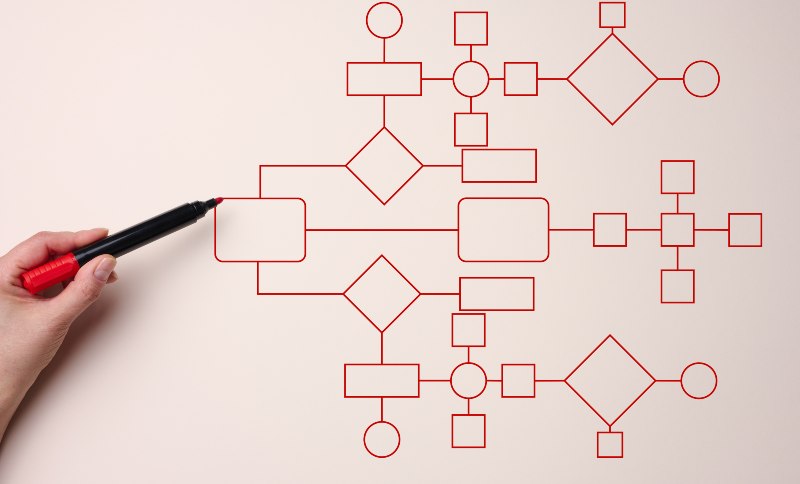From Concept to Reality: Software Development Process

So, you’re looking to transform a workflow from manual and slow, to smooth and automated using your own custom software. But taking it from concept to reality isn’t that simple.
You may not realize it yet, but you’re now about to walk into a very deep, complex maze, called the Software Development Process. Your success will depend on how much you understand this process so that you can choose and work with the right team to develop your software project.
We’re going to break the software development process down so the next time you step into a software development meeting you’re clued up and ready to turn your software needs into a well-functioning product.
What is Software Development Process
Whether it is an operating system or an application that is being built, software cannot be developed successfully without a process in place.
A software development process is a structured approach for teams to develop software in a cost-effective, systematic way.
It involves the designing, development, and maintenance of a software.
The Process: Software Development Life Cycle
The software development process, also known as a Software Development Life Cycle (SDLC), shows all the steps necessary to successfully complete a software project within the estimated budget and timeframe.
Software Development Process Benefits
Without these steps in the software development process, software development teams will be flying in blind, under-delivering on projects and exceeding budget.
Luckily, the Software Development Life Cycle irons out all the details, preparing everyone involved in the project for what is required of them.
Here are the other benefits of a software development process:
- Vocabulary: Everyone will understand the technical terms to be used during the project, like data integration, backend development, cache, etc.
- Definition: Each step of the software development process will be defined to allow for a smooth running project
- Risks: Along with the requirements of the project, risks will be identified and managed
- Communication: How everyone communicates will be outlined and agreed upon
- Estimation: Plans, budget, and timelines will be documented to ensure the project follows them.
- Roles and responsibilities: All team members will have their roles and responsibilities clearly laid out.
- Scope: The scope or requirements are well-detailed.
- Standardization: When certain issues are encountered there is a clear, standard way of dealing with it.
- Data Integrity: As the development team maintains best practices throughout the project, data corruption will be less likely.
- Customer Satisfaction: All the above will lead to greater customer satisfaction overall because the development team will deliver a product that exceeds their expectations while also staying within the allotted timeframe and budget.
Software Development Process
The terminology for software development processes differs for some organizations but the general process stays the same.
A software development process usually has the following steps:
- Planning
- Designing
- Developing
- Testing
- Releasing
- Reviewing and Maintenance
Planning
Most people have vague ideas of what their software solution should be like to accomplish their goals. The software development process facilitates the translating of those ideas into requirements and scope.
The project team starts with requirements gathering, which is discovering the needs and wants of the client. This would mean outlining the scope and desired outcomes of the software solution.
The project team will likely ask the following questions:
- Who are the users for this software?
- What is the intended purpose of the software?
- What data will be required?
- What are the risks associated with the project
As the team analyzes all the requirements, a document is created with all the specifications.
Design
The planning isn’t done quite yet. Next, the developers will create Design Specification Documents (DSD) and get to planning and designing the software to meet the requirements efficiently.
The DSD may include:
- The technical architecture design of the software
- How the software will function in the backend
- How the software solution will look and work in the frontend
- What security measures will be taken to ensure data integrity
- What are the testing methods to be used
Based on this, resources will be allocated, and costs and timelines will be estimated.
Once all these details are documented, the stakeholders will review and approve the design specifications.
Developing
The developers do what they do best: Development! This is the longest phase in the software development process.
Within this step, there will be milestones and tasks broken down to keep the project on track.
The software is coded, and the databases and interfaces are built according to the scope. If required, the software will be integrated with existing systems.
The software is then deployed into an isolated environment for testing purposes.
Note: We believe that the development team should not wait to build the entire software solution before testing. This could lead to a less accurate end product due to less feedback from the clients.
Testing
You won’t know if the software meets the requirements without testing it. The following will be tested:
- If the software works according to the documented scope.
- If the code works as the developers intended.
- If there are any bugs or defects.
The testers and end users will test against these criteria and report their findings to the developers to fix. Here’s a list of the types of testing that can be done in this stage:
- Integration testing
- Functional testing
- Non-functional testing
- Performance testing
- System testing
- Acceptance testing
Once the defects are fixed, a new round of testing will commence. The cycle will continue until the software works according to the requirements.
Releasing
Once the application is working as expected and the software solution has been approved, the software is ready to be released into the production environment to go live.
This means that end users will be able to use the application for real tasks! Users will now operate the software for its intended purpose.
Reviewing and Maintenance
A developer’s work is never done after the software solution has gone live. End users will find bugs and defects, even if the team did numerous rounds of testing. It’s a part of the software development lifecycle!
In this phase of the software development process, the software developed will need to be supported and maintained through bug fixes, requested changes, etc.
Internally the team will also have a discussion on what could’ve been done better or more efficiently because there’s always room for improvement!
Software Development Process Approaches
The software development process seems simple enough, right? Clear cut and standard. But when it comes to developing software, there’s nothing clear cut about it.
Every project is different because users have different requirements. There could be time constraints or budget constraints. Not to mention the risks associated with different projects.
It can’t be a customized software solution if the above components are not taken into account.
Therefore, there are different methodologies or approaches to the software development process. Here are the ones we’ll be going through:
- Waterfall
- Agile
- Incremental
Waterfall approach
The Waterfall approach is linear in nature. It follows a sequential flow, meaning a new phase can only be started once the previous is completed.
With the Waterfall approach, the entire development process is moved through and then the product is launched.
This software development process is the oldest approach, and it is quite rigid. The benefits of Waterfall are the same for the software development process because it follows the same steps exactly:
- Planning
- Designing
- Developing
- Testing
- Releasing
- Reviewing and Maintenance
A Waterfall approach may work best for an inventory management system for a huge bureaucratic organization. The organization would give the specifications of what needs to be completed and the team would plan the project out based on that and develop the entire software solution. Once developed, the organization will test the Inventory Management System and sign-off once approved.
Documentation will be signed at every stage of the software development process for the bureaucratic organization’s records.
As we move more and more into a digitally driven environment, there are only a few projects that suit the Waterfall approach. Here’s when it could work:
- Rigid organizational structures with little flexibility
- Many documentation sign offs are required
- No user input is required
- Tightly written scope with no dynamism
There are very few overlaps in the process and testing only happens once, leaving room for errors and delays.
Most businesses are becoming more flexible to adapt to the ever-changing global village, rendering waterfall a much less suitable software development process.
Agile Approach
The Agile approach is becoming increasingly popular due to its focus on adaptability and customer satisfaction. And it’s our personal favorite!
With Agile, the product is built and launched in small phases, each more advanced than the next. This means you get to market faster, get feedback quicker, and ultimately get a working product that more closely fits what is actually needed.
Within Agile, there are 4 methods called Scrum, kanban, Adaptive Project Framework, and Extreme Project Management. Scrum is the most popular, and the one we’ll be going into more depth on.
Agile uses the same steps of Waterfall but broken down into sprints where certain stages repeat themselves.
In the scrum method, the team uses sprints. A sprint is usually between 2-4 weeks where features are built, tested, and approved before moving on to a new set of features.
Agile has the following benefits:
- Improved collaboration with stakeholders
- Ability to adapt to change efficiently
- Good risk management due to constant communication
- Frequent releases, leading to continuous improvement
When does Agile work best?
- Flexible budgets and timelines
- Users’ input is vital to the software’s development
- The stakeholders are not risk-averse
- The required resources are available for as long as needed
An example would be a business process automation, where the main scope is clear but new features may be added in after some rounds of testing to enhance the functionality.
Incremental Approach
When you’re not sure if Waterfall or Agile is right, you can choose the mixture of the 2: Incremental. In this approach to the software development process, requirements are divided into modules or increments.
This means that features are split into increments and each increment is treated as a mini-project. Once the requirements are gathered and analyzed, the first increment will commence.
The increments in the software development process consists of:
- Design and Development
- Testing
- Implementation
After every release, what was developed adds onto the previous increment until the software solution is complete.
For example, when developing software for an operating system like Windows, you would create new versions or updates on top of the existing software.
There are a few benefits of the Incremental approach:
- Frequent testing of features
- Modifications are easy to make
- Quicker risk detection
When does Incremental work best?
- The scope is clear
- More flexibility is needed than with Waterfall approach
- The stakeholders prefer a long-term plan and continuous maintenance
Roles in a Software Development Process
Who are the resources that make the software development process cogs turn?
Let’s go into detail on the different roles and where they fit into the software development process.
- Product Owner/Manager
- Product Designer
- Frontend Developer
- Backend Developer
- Technical Architect
- Tester
Product Owner/Manager
This person works to ensure the project’s objectives are met. They gather and document the scope of work that needs to be executed by the project team.
They meet with the team regularly to monitor progress of the software development process and keep the team on track.
Product Designer
Where do the buttons go? How will the menu look?
Ask the Product Designer!
This person will work on the look and feel of the software solution, and they can also be referred to as a UX (User Experience) and UI (User Interface) designer.
This means that they are responsible for the experience the end user will have when they use the application.
Developer
The developers convert the UX and UI requirements into an actual application that the user will operate.
They are responsible for the functionality, data storage and the linkage between the user experience and the server.
There are 2 main types of developers in software development projects:
Frontend Developer
A frontend developer is the person that translates the user experience into actual functionality.
This means that they work on the dashboard of the application.
Backend Developer
A backend developer works on the servers of the software.
They are tasked with writing business logic, processing data, communicating with other systems, and storing and retrieving data.
Tester
Testing could be done by a separate individual called a tester or by someone already part of the team, like the product owner or product designer for example.
This person will carry out the necessary tests to ensure the code works as intended and the software solution operates how the end user expects it to.
Measuring The Success of a Project With Software Development Process Metrics
The stakeholders won’t give the development team a badge that says, “Well done!” when deciding if the project was a success.
First, there needs to be measurable goals that can be linked to software development process Metrics. The metrics should help the team measure the planned performance against the actual performance.
Below are some metrics that can be used to determine the success of a software development process:
- Lead time: How much time did it take between phases and what were the causes of delays?
- Coding and Development: Were there any issues encountered in the development phase that could have been corrected more efficiently?
- Team: How was the synergy between the team members? Could there be improvements in communication?
- Change: How were change requests dealt with?
- Risks: Were there any risks that cropped up? Could they have been identified earlier?
- Risk Management: How were risks managed throughout the project?
- Timelines and Budget: Did the project get completed within the timeframe and cost estimations, if not: what were the causes for delays?
- Customer Satisfaction: What did the customer say about the end product and how has support and maintenance impacted that?
Where Do You Go from Here?
Beyond understanding the software development process, project teams have to put it into practice.
We believe that a well-defined, yet flexible software development process will lead to better risk management, collaboration, and innovative software solutions. Which in turn leads to greater customer satisfaction!
As a software development company, we use our expertise and an agile approach to deliver impactful software solutions that exceed client’s expectations.
If you’re ready to take your next step in your journey to a more digital business, then contact us to let us know what software you want developed. We can turn your vision into reality!

Want Help With Your Software Project?
Get Our Free Ebook: How to Build Winning Custom Software – A Guide For Businesses and Entrepreneurs
By subscribing, you agree to get emails from Co-Foundry. We’ll respect your privacy and you can unsubscribe at any time.






